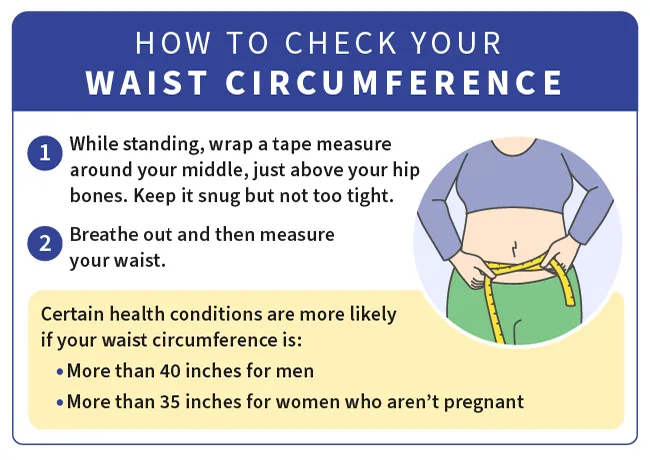You've probably heard the term BMI (body mass index). It's based on height and weight, and it's been widely used to determine who’s underweight, normal weight, overweight, or has obesity.
But BMI has some well-known flaws.
It can’t tell you anything about your body composition, including how much muscle you have or where fat resides in your body. (Deep belly fat, or visceral fat, is particularly risky). And it doesn’t take your age, gender, or ethnicity into account.
Even so, BMI is “very useful” in most cases, as long as you don’t rely on it alone, says Mustafa Hussain, MD, associate professor of surgery and director of the Center for the Surgical Treatment of Obesity at the University of Chicago Medicine.
“BMI is just one data point,” Hussain says. ”If you hang everything on BMI, you might lose sight of something else.”
BMI Is ‘Useful’ but ‘Not Perfect’
Calculated from a person's height and weight, BMI breaks down into four categories:
- Underweight: BMI below 18.5
- Normal: BMI of 18.5 to 24.9
- Overweight: BMI of 25 to 29.9
- Obesity: BMI of 30 or higher
How useful is that number?
Among doctors, “I think there’s an awareness that BMI is not perfect,” Hussain says. But since it’s easy to calculate, “I don’t think BMI is going away.”
“It’s a very good screening tool to determine if someone is at risk for medical conditions secondary to their weight,” Hussain says.
Judging whether someone has obesity based only on their size is old-fashioned and not terribly useful, says Scott Kahan, MD, MPH, director of the National Center for Weight and Wellness.
Kahan specializes in helping people manage extra weight that can lead to health problems, including diabetes and heart disease. That includes some people whose health isn’t what you might expect based on their BMI.
"They're heavy. Their BMI puts them in the obesity range. And yet on every level that we look at, their health is actually quite good," Kahan says. "Their cholesterol and blood pressure are excellent. Their blood sugar is excellent. They don't seem to have any health effects associated with their excess weight."
BMI is a way to screen people, not to define their health, Kahan and Hussain say.
“It should raise alarms if you do put your numbers into one of those [BMI] calculators and it comes out that you’re overweight or obese,” Hussain says. “You should talk to your doctor about what you could do to try to limit your risk factors for metabolic disease.”
Body fat percentage might be more accurate in reflecting risk, Hussain says. “If your body fat percentage is over 30%, certainly over 35%, you are at much higher risk of diabetes and heart disease and other metabolic disease.”
BMI and Body Composition
Your BMI doesn't reveal either of these things:
How muscular you are. A few people have high BMIs but don't have much body fat. Their muscle tissue pushes up their weight. Kahan points to very muscular people, like football players or body builders. “Their BMI shows up pretty high, and yet their body fat is actually pretty low," Kahan says.
Take LeBron James, for example. His BMI has been reported to be 26.8, which is in the overweight category. “But he’s probably one of the healthiest people out there, right?” Hussain says. Still, he points out, “There aren’t a lot of people like LeBron James walking around.”
Some people who aren’t active may have a normal BMI but have a surprising amount of body fat.
"They have very low levels of muscle and bone: often elderly people, those in poor shape, sometimes those who are sick. Their BMI can look in the normal range, even though they have quite a lot of body fat in comparison to their lean body mass," Kahan says. "Ultimately, they have similar risks as people who carry lots of body fat and have a high BMI."
Deep belly fat. Is your figure shaped more like an apple or a pear? The location of your fat makes a difference to your health. Generally, it's the deep belly fat, or the "apple" shape, that has a higher health risk compared to the subcutaneous fat that’s right under the skin. When fat settles around the waist instead of the hips, the chances of heart disease and type 2 diabetes go up. Fat that builds up on the hips and thighs, or the "pear" shape, isn't as potentially harmful.
BMI, Age, and Ethnicity
The notion of an ideal BMI may vary for people of different ages and backgrounds.
Among seniors, having a low BMI could be a marker for frailty, Hussain notes.
“Older patients do benefit from a little bit of extra weight,” he says. “You don’t want them to be in that lower BMI end because that’s when they get risks of falls and susceptibility to infections, things like that.”
Frailty prevention also includes strength training, which experts say it’s never too late in life to start.
There are also differences in BMI and health risk among ethnic groups. “Those nuances are something that we are definitely paying more attention to now,” Hussain says.
For example, Asian American people tend to develop health risks, including the risk of diabetes, at lower BMIs than White people. A healthy BMI for Asian people ranges from 18.5 to 23.9, a full point lower than the standard range. And Asian people are considered obese at a BMI of 27 or higher, compared to the standard BMI obesity measure of 30 or higher.
Some researchers say these ranges should be lower. In 2023, researchers recommended that for Asian and South Asian people, the BMI range for overweight should be 23-24.9 and obesity should start at a BMI of 25.
“Asians are at higher risk for metabolic disease such as diabetes, heart disease, at a much lower BMI than previously thought,” Hussain says. Asian patients with a BMI of 27 or higher “should actually be considered for more aggressive interventions to treat their weight and metabolic disease.” Every Asian American person with a BMI of at least 23 should be screened for type 2 diabetes, according to the Joslin Diabetes Center.
Among Black Americans, “BMI tends to overestimate Black people as being overweight when, in actuality, their BMI is high because of muscle mass and not increased body fat associated with obesity,” the Obesity Medicine Association states.
BMI was created based on data from White populations, an issue that the American Medical Association (AMA) noted in 2023. The AMA stated then that BMI has “significant limitations” in evaluating any person, and doctors should keep that in mind when diagnosing obesity.
Body Composition Tools
If BMI can’t tell the full story, you may want to use your measuring tape as well as your scale.
Waist circumference. Wrap the tape measure around your waist. Keep it level, aiming for the belly button.

The risk of health problems is greater in these groups:
- Men with a waist circumference of 40 or more inches who aren’t Asian. For Asian men, it’s 35.5 or more inches.
- Women with a waist circumference of 35 or more inches who aren’t Asian and 31.5 inches for Asian women.
Waist-to-height ratio. This compares your waist measurement to your height. It may be even more helpful than waist circumference alone, Kahan says. The goal is for your waist circumference to be less than half of your height.
Body roundness index (BRI). This index is based on a mathematical formula that relates your waist circumference to your height. You can find body roundness index calculators online. The BRI concept is still fairly new and needs to be validated in other studies but shows promise, researchers say.
Waist-to-hip ratio. To get this ratio, measure your waist circumference, and then measure around your hips. Then divide your waist measurement by your hip measurement. According to the World Health Organization, men should have a waist-to-hip ratio of less than 0.90 centimeters and women less than 0.85 centimeters.
Skinfold thickness measurement. This low-tech method uses calipers to pinch some skin and measure its thickness. It’s one way to estimate how much subcutaneous fat is in various areas of the body. But it doesn’t check on visceral (deep belly) fat.
DXA (or DEXA) scan. This type of scan looks at your whole body. It’s used to check bone mineral density in people at risk of osteoporosis, and it can also check on where fat is located in your body. Costs vary and these tests aren’t necessary for most people, so they may not be covered by insurance.
MRI or ultrasound. These tests can also check on body composition, but they aren’t likely needed.



